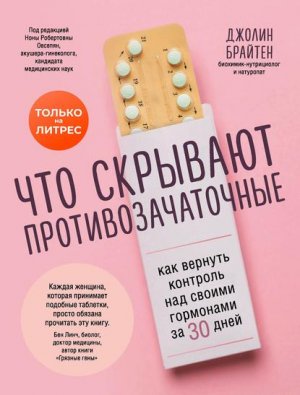×òî ñêðûâàþò ïðîòèâîçà÷àòî÷íûå. Êàê âåðíóòü êîíòðîëü íàä ñâîèìè ãîðìîíàìè çà 30 äíåé Áðàéòåí Äæîëèí

Fresko, I., et al. “Anti-Saccharomyces Cerevisiae Antibodies (ASCA) in Behet’s Syndrome”. Clinical and Experimental Rheumatology 23, suppl. 38 (2005): S67–70.
Frieri, M. “Neuroimmunology and Inflammation: Implications for Therapy of Allergic and Autoimmune Diseases”. Annals of Allergy, Asthma, and Immunology 90, no. 6, suppl. 3 (2003): S34–40.
Gameiro, C. M., et al. “Menopause and Aging: Changes in the Immune System – A Review”. Maturitas 67, no. 4 (2010): 316–20.
Gawron, L., et al. “Oral Contraceptive Use and Crohn’s Disease Complications”. Gastroenterology 151, no. 5 (2016): 1038–39.
https://www.gastrojournal.org/article/S0016-5085 (16)35072-7/fulltext?code=ygast-site.
Harmon, Q. E., et al. “Use of Estrogen-Containing Contraception Is Associated with Increased Concentrations of 25-Hydroxy Vitamin D”. Journal of Clinical Endocrinology and Metabolism 101, no. 9 (2016): 3370–77. https://academic.oup.com/jcem/article /101/9/3370/2806637.
Hartmann, P., et al. “The Intestinal Microbiome and the Leaky Gut as Therapeutic Targets in Alcoholic Liver Disease”. Frontiers in Physiology 3 (2012): 402.
Hu, M. L., et al. “Effect of Ginger on Gastric Motility and Symptoms of Functional Dyspepsia”. World Journal of Gastroenterology 17, no. 1 (2011): 105–10.
Jacobsen, B. K., et al. “Soy Isoflavone Intake and the Likelihood of Ever Becoming a Mother: The Adventist Health Study-2”. International Journal of Women’s Health 6 (2014): 377–84.
Jeferson, W. N. “Adult Ovarian Function Can Be Affected by High Levels of Soy”. Journal of Nutrition 140, no. 12 (2010): 2322S–25S.
Jessop, D. S., et al. “Effects of Stress on Inflammatory Autoimmune Disease: Destructive or Protective?” Stress 7, no. 4 (2004): 261–66.
Khalili, H., et al. “Association Between Long-Term Oral Contraceptive Use and Risk of Crohn’s Disease Complications in a Nationwide Study”. Gastroenterology 150, no. 7 (2016): 1561–67.e1. https://www.gastrojournal.org/article/S00165085(16)002328/fulltext?code=ygast-site.
Khalili, H., et al. “Oral Contraceptives, Reproductive Factors, and Risk of Inflammatory Bowel Disease”. Gut 62, no. 8 (2013): 1153–59.
Khalili, H., et al. “Sa1231 Oral Contraceptive Use and Risk of Surgery Among Crohn’s Patients”. Gastroenterology 148, no. 4, suppl. 1 (2015): S264–65.
Kwa, M., et al. “The Intestinal Microbiome and Estrogen Receptor – Positive Female Breast Cancer”. Journal of the National Cancer Institute 108, no. 8 (2016).
Long, M. D., et al. “Shifting Away from Estrogen-Containing Oral Contraceptives in Crohn’s Disease”. Gastroenterology 150, no. 7 (2016): 1518–20.
Luborsky, J., et al. “Ovarian Antibodies, FSH, and Inhibin B: Independent Markers Associated with Unexplained Infertility”. Human Reproduction 15, no. 5 (2000): 1046–51.
Lyngs, J., et al. “Association Between Coffee or Caffeine Consumption and Fecundity and Fertility: A Systematic Review and Dose-Response Meta-Analysis”. Clinical Epidemiology 9 (2017): 699–719.
McMichael-Phillips, D. F., et al. “Effects of Soy-Protein Supplementation on Epithelial Proliferation in the Histologically Normal Human Breast”. American Journal of Clinical Nutrition 68, suppl. 6 (1998): 1431S–35.
Mulak, A., et al. “Sex Hormones in the Modulation of Irritable Bowel Syndrome”. World Journal of Gastroenterology 20, no. 10 (2014): 2433–48.
Petrakis, N. L., et al. “Stimulatory Influence of Soy Protein Isolate on Breast Secretion in Pre- and Postmenopausal Women”. Cancer Epidemiology, Biomarkers, and Prevention 5, no. 10 (1996): 785–94.
Petri, M., et al. “Oral Contraceptives and Systemic Lupus Erythematosus”. Arthritis and Rheumatism 40, no. 5 (1997): 797–803.
Quah, S. Y., et al. “N-Acetylcysteine Inhibits Growth and Eradicates Biofilm of Enterococcus Faecalis”. Journal of Endodontics 38, no. 1 (2012): 81–85.
Rizzo, G., et al. “Soy, Soy Foods, and Their Role in Vegetarian Diets”. Nutrients 10, no. 1 (2018): 43.
Schliep, K. C., et al. “Caffeinated Beverage Intake and Reproductive Hormones Among Premenopausal Women in the BioCycle Study”. American Journal of Clinical Nutrition 95, no. 2 (2012): 488–97.
Scrimgeour, A. G., et al. “Zinc and Micronutrient Combinations to Combat Gastrointestinal Inflammation”. Current Opinion in Clinical Nutrition and Metabolic Care 12, no. 6 (2009): 653–0.
Sieron, D., et al. “The Effect of Chronic Estrogen Application on Bile and Gallstone Composition in Women with Cholelithiasis”. Minerva Endocrinologica 41, no. 1 (2016): 19–27.
Skrovanek, S., et al. “Zinc and Gastrointestinal Disease”. World Journal of Gastrointestinal Pathophysiology 5, no. 4 (2014): 496–513.
Stojanovich, L., et al. “Stress as a Trigger of Autoimmune Disease”. Autoimmunity Reviews 7, no. 3 (2008): 209–13.
Sun, C. L., et al. “Dietary Soy and Increased Risk of Bladder Cancer: The Singapore Chinese Health Study”. Cancer Epidemiology, Biomarkers, and Prevention 11, no. 12 (2002): 1674–77.
Tayyebi-Khosroshahi, H., et al. “Effect of Treatment with Omega-3 Fatty Acids on C-Reactive Protein and Tumor Necrosis Factor-Alfa in Hemodialysis Patients”. Saudi Journal of Kidney Diseases and Transplantation 23, no. 3 (2012): 500–6.
Torne Research. “Calcium-D-Glucarate”. Alternative Medicine Review 7, no. 4 (2002): 336–39.
Tralau, T., et al. “Insights on the Human Microbiome and Its Xenobiotic Metabolism: What Is Known About Its Effects on Human Physiology?” Expert Opinion on Drug Metabolism and Toxicology 11, no. 3 (2015): 411–25.
Tung, K. S. K., et al. “Mechanisms of Autoimmune Disease in the Testis and Ovary”. Human Reproduction Update 1, no. 1 (1995): 35–50.
Vojdani, A., et al. “Cross-Reaction Between Gliadin and Different Food and Tissue Antigens”. Food and Nutrition Sciences 4, no. 1 (2013): 20–32.
Wang, B., et al. “Glutamine and Intestinal Barrier Function”. Amino Acids 47, no. 10 (2015): 2143–54.
Wang, B., et al. “L-Glutamine Enhances Tight Junction Integrity by Activating CaMK Kinase 2-AMP-Activated Protein Kinase Signaling in Intestinal Porcine Epithelial Cells”. Journal of Nutrition 146, no. 3 (2016): 501–8.
White, L., et al. “Prevalence of Dementia in Older Japanese-American Men in Hawaii: The Honolulu-Asia Aging Study”. JAMA 276, no. 12 (1996): 955–60.
Williams, W. V. “Hormonal Contraception and the Development of Autoimmunity: A Review of the Literature”. Linacre Quarterly 84, no. 3 (2017): 275–95.
Yan, Y., et al. “Omega-3 Fatty Acids Prevent Inflammation and Metabolic Disorder Trough Inhibition of NLRP3 Inflammasome Activation”. Immunity 38, no. 6 (2013): 1154–63.
Yang, Q., et al. “Added Sugar Intake and Cardiovascular Diseases Mortality Among US Adults”. JAMA Internal Medicine 174, no. 4 (2014): 516–24.
https://jamanetwork.com /journals/jamainternalmedicine/fullarticle/1819573.
Yates, C. M., et al. “Pharmacology and Therapeutics of Omega-3 Polyunsaturated Fatty Acids in Chronic Inflammatory Disease”. Pharmacology and Therapeutics 141, no. 3 (2014): 272–82.
Zhao, T., et al. “N-Acetylcysteine Inhibit Biofilms Produced by Pseudomonas Aeruginosa”. BMC Microbiology 10 (2010): 140.
Zitvogel, L. “Cancer and the Gut Microbiota: An Unexpected Link”. Science Translational Medicine 7, no. 271 (2015): 271ps1.
Ajjan, R., et al. “The Pathogenesis of Hashimoto’s Thyroiditis: Further Developments in Our Understanding”. Hormone and Metabolic Research 47, no. 10 (2015): 702–10.
Alexander, E. K., et al. “2017 Guidelines of the American Thyroid Association for the Diagnosis and Management of Thyroid Disease During Pregnancy and the Postpartum”. Thyroid 27, no. 3 (2017): 315–89. https://www.liebertpub.com/doi/pdfplus/10.1089/thy.2016.0457.
Ayhan, M. G., et al. “The Prevalence of Depression and Anxiety Disorders in Patients with Euthyroid Hashimoto’s Thyroiditis: A Comparative Study”. General Hospital Psychiatry 36, no. 1 (2014): 95–98.
Bajaj, J. K., et al. “Various Possible Toxicants Involved in Thyroid Dysfunction: A Review”. Journal of Clinical and Diagnostic Research 10, no. 1 (2016): FE01–03.
Balzs, C., et al. “Effect of Selenium on HLA-DR Expression of Thyrocytes”. Autoimmune Diseases (2012), article ID 374635.
Ban, Y., et al. “The Contribution of Immune Regulatory and Thyroid Specific Genes to the Etiology of Graves’ and Hashimoto’s Diseases”. Autoimmunity 36, nos. 6–7 (2003): 367–79.
Ban, Y., et al. “Genetic Susceptibility in Thyroid Autoimmunity”. Pediatric Endocrinology Reviews 3, no. 1 (2005): 20–32.
Blackwell, J. “Evaluation and Treatment of Hyperthyroidism and Hypothyroidism”. Journal of the American Association of Nurse Practitioners 16, no. 10 (2004): 422–25.
Bunevicius, A., et al. “Hypothalamic-Pituitary-Thyroid Axis Function in Women with a Menstrually Related Mood Disorder”. Psychosomatic Medicine 74, no. 8 (2012): 810–16.
Caturegli, P., et al. “Autoimmune Thyroid Diseases”. Current Opinion in Rheumatology 19, no. 1 (2007): 44–48.
Cauci, S., et al. “Effects of Third-Generation Oral Contraceptives on High-Sensitivity C-Reactive Protein and Homocysteine in Young Women”. Obstetrics and Gynecology 111, no. 4 (2008): 857–64.
Chandrasekhar, K., et al. “A Prospective, Randomized Double-Blind, Placebo-Controlled Study of Safety and Efficacy of a High-Concentration Full-Spectrum Extract of Ashwagandha Root in Reducing Stress and Anxiety in Adults”. Indian Journal of Psychological Medicine 34, no. 3 (2012): 255–62.
Checchi, S., et al. “L-Thyroxine Requirement in Patients with Autoimmune Hypothyroidism and Parietal Cell Antibodies”. Journal of Clinical Endocrinology and Metabolism 93, no. 2 (2008): 465–69.
Ch’ng, C. L., et al. “Celiac Disease and Autoimmune Thyroid Disease”. Clinical Medicine and Research 5, no. 3 (2007): 184–92.
Cojocaru, M., et al. “Multiple Autoimmune Syndrome”. Maedica 5, no. 2 (2010): 132–34. Contempre, B., et al. “Effect of Selenium Supplementation in Hypothyroid Subjects of an Iodine and Selenium Deficient Area: The Possible Danger of Indiscriminate Supplementation of Iodine-Deficient Subjects with Selenium”. Journal of Endocrinology and Metabolism 73, no. 1 (1991): 213–15.
Daher, R., et al. “Consequences of Dysthyroidism on the Digestive Tract and Viscera”. World Journal of Gastroenterology 15, no. 23 (2009): 2834–38.
Dama, M., et al. “Thyroid Peroxidase Autoantibodies and Perinatal Depression Risk: A Systematic Review”. Journal of Affective Disorders 198 (2016): 108–21.
De Herder, W. W., et al. “On the Enterohepatic Cycle of Triiodothyronine in Rats; Importance of the Intestinal Microflora”. Life Sciences 45, no. 9 (1989): 849–56.
Divani, A. A., et al. “Effect of Oral and Vaginal Hormonal Contraceptives on Inflammatory Blood Biomarkers”. Mediators of Inflammation (2015), article ID 379501.
Drutel, A., et al. “Selenium and the Thyroid Gland: More Good News for Clinicians”. Clinical Endocrinology 78, no. 2 (2013): 155–64.
Ebert, E. C. “The Thyroid and the Gut”. Journal of Clinical Gastroenterology 44, no. 6 (2010): 402–6.
Fan, Y., et al. “Selenium Supplementation for Autoimmune Thyroiditis: A Systematic Review and Meta-Analysis”. International Journal of Endocrinology 2014, no. 1 (2014): 904573.
Fisher, D. A. “Physiological Variations in Thyroid Hormones: Physiological and Pathophysiological Considerations”. Clinical Chemistry 42, no. 1 (1996): 135–39.
Foster, J. A., et al. “Stress and the Gut-Brain Axis: Regulation by the Microbiome”. Neurobiology of Stress 7 (2017): 124–36.
Grtner, R., et al. “Selenium Supplementation in Patients with Autoimmune Thyroiditis Decreases Thyroid Peroxidase Antibodies Concentrations”. Journal of Clinical Endocrinology and Metabolism 87, no. 4 (2002): 1687–91.
Gerenova, J., et al. “Clinical Significance of Autoantibodies to Parietal Cells in Patients with Autoimmune Thyroid Diseases”. Folia Medica 55, no. 2 (2013): 26–32.
Gierach, M., et al. “Hashimoto’s Thyroiditis and Carbohydrate Metabolism Disorders in Patients Hospitalised in the Department of Endocrinology and Diabetology of Ludwik Rydygier Collegium Medicum in Bydgoszcz Between 2001 and 2010”. Endokrynologia Polska 63, no. 1 (2012): 14–17.
Girdler, S. S., et al. “Historical Sexual Abuse and Current Thyroid Ais Profiles in Women with Premenstrual Dysphoric Disorder”. Psychosomatic Medicine 66, no. 3 (2004): 403–10.
Gorini, P., et al. “The Stimulating Effect of a Cytosol Extract from Regenerating Liver on Isolated Hepatocytes and the Positive Role of Insulin”. Italian Journal of Surgical Sciences 18, no. 3 (1988): 201–5.
Guggenheim, A. G., et al. “Immune Modulation from Five Major Mushrooms: Application to Integrative Oncology”. Integrative Medicine 13, no. 1 (2014): 32–44.
Guhad, F. A., et al. “Salivary IgA as a Marker of Social Stress in Rats”. Neuroscience Letters 216, no. 2 (1996): 137–40.
Haugen, B. R. “Drugs that Suppress TSH or Cause Central Hypothyroidism”. Best Practice and Research. Clinical Endocrinology and Metabolism 23, no. 6 (2009): 793–800.
Hays, M. T. “Thyroid Hormone and the Gut”. Endocrine Research 14, nos. 2–3 (1988): 203–24.
Houston, M. “The Role of Magnesium in Hypertension and Cardiovascular Disease”. Journal of Clinical Hypertension 13, no. 11 (2011): 843–47.
Hybenova, M., et al. “The Role of Environmental Factors in Autoimmune Thyroiditis”. Neuro Endocrinology Letters 31, no. 3 (2010): 283–89.
Kahaly, G. J., et al. “Thyroid Hormone Action in the Heart”. Endocrine Reviews 26, no. 5 (2005): 704–28. https://academic.oup.com/edrv/article/26/5/704/2355198.
Kakuno, Y., et al. “Menstrual Disturbances in Various Thyroid Diseases”. Endocrine Journal 57, no. 12 (2010): 1017–22.
Keely, E. J. “Postpartum Thyroiditis: An Autoimmune Thyroid Disorder Which Predicts Future Thyroid Health”. Obstetric Medicine 4, no. 1 (2011): 7–11.
Kimura, H., et al. “Chemokine Orchestration of Autoimmune Thyroiditis”. Thyroid 17, no. 10 (2007): 1005–11.
Kloosterboer, H. J., et al. “Effects of Tree Low-Dose Contraceptive Combinations on Sex Hormone – Binding Globulin, Corticosteroid Binding Globulin and Antithrombin III Activity in Healthy Women: Two Monophasic Desogestrel Combinations (Containing 0.020 or 0.030 mg Ethinylestradiol) and One Triphasic Levonorgestrel Combination”. Acta Obstetricia et Gynecologica Scandinavica 66, suppl. 143 (1987): 41–44.
Koutras, D. A. “Disturbances of Menstruation in Thyroid Disease”. Annals of the New York Academy of Sciences 816 (1997): 280–84.
Krassas, G. E. “Thyroid Disease and Female Reproduction”. Fertility and Sterility 74, no. 6 (2000): 1063–70.
Lauritano, E., et al. “Association Between Hypothyroidism and Small Intestinal Bacterial Overgrowth”. Journal of Clinical Endocrinology and Metabolism 92, no. 11 (2007): 4180–84.
Mackawy, A. M. H., et al. “Vitamin D Deficiency and Its Association with Thyroid Disease”. International Journal of Health Sciences 7, no. 3 (2013): 267–75.
Mansournia, N., et al. “The Association Between Serum 25OHD Levels and Hypothyroid Hashimoto’s Thyroiditis”. Journal of Endocrinological Investigation 37, no. 5 (2014): 473–76.
Olsson, E. M. G., et al. “A Randomised, Double-Blind, Placebo-Controlled, Parallel-Group Study of the Standardised Extract SHR-5 of the Roots of Rhodiola Rosea in the Treatment of Subjects with Stress-Related Fatigue”. Planta Medica 75 (2009): 105–12.
Ongphiphadhanakul, B., et al. “Tumor Necrosis Factor-Alpha Decreases Thyrotropin-Induced 5’-Deiodinase Activity in FRTL-5 Thyroid Cells”. European Journal of Endocrinology 130, no. 5 (1994): 502–7.
Palmery, M., et al. “Oral Contraceptives and Changes in Nutritional Requirements”. European Review for Medical and Pharmacological Sciences 17, no. 13 (2013): 1804–13.
Peterson, A. M., et al. “The Anti-Inflammatory Effect of Exercise”. Journal of Applied Physiology 98, no. 4 (2005): 1154–62.
Ramya, M. R., et al. “Menstrual Disorders Associated with Thyroid Dysfunction”. International Journal of Reproduction, Contraception, Obstetrics, and Gynecology 6, no. 11 (2017): 5113–17. http://www.ijrcog.org/index.php/ijrcog/article/viewFile /3718/2946.
Rettori, V., et al. “Central Action of Interleukin-1 in Altering the Release of TSH, Growth Hormone, and Prolactin in the Male Rat”. Journal of Neuroscience Research 18, no. 1 (1987): 179–83.
Sapolsky, R. M., et al. “The Neuroendocrinology of Stress and Aging: The Glucocorticoid Cascade Hypothesis”. Endocrine Reviews 7, no. 3 (1986): 284–301.
Srensen, C. J., et al. “Combined Oral Contraception and Obesity Are Strong Predictors of Low Grade Inflammation in Healthy Individuals: Results from the Danish Blood Donor Study (DBDS)”. PLoS One 9, no. 2 (2014): e88196.
Stagnaro-Green, A. “Approach to the Patient with Postpartum Thyroiditis”. Journal of Clinical Endocrinology and Metabolism 97, no. 2 (2012): 334–42.
Steingold, K. A., “Comparison of Transdermal to Oral Estradiol Administration on Hormonal Hepatic Parameters in Women with Premature Ovarian Failure”. Journal of Clinical Endocrinology and Metabolism 73, no. 2 (1991): 275–80.
Stojanovich, L., et al. “Stress as a Trigger of Autoimmune Disease”. Autoimmunity Reviews 7, no. 3 (2008): 209–13.
Surks, M. I., et al. “Drugs and Thyroid Function”. New England Journal of Medicine 333, no. 25 (1995): 1688–94.
Torp, V. J. “Effect of Oral Contraceptive Agents on Vitamins and Mineral Requirements”. Journal of the American Dietetic Association 76, no. 6 (1980): 581–84.
Verlarde-Mayol, C., et al. “Pernicious Anemia and Autoimmune Thyroid Disease in Elderly People”. [In Spanish.] Revista Espaola de Geriatra y Gerontologa 50, no. 3 (2015): 126–28.
Walter, K. N., et al. “Elevated Thyroid Stimulating Hormone Is Associated with Elevated Cortisol in Healthy Young Men and Women”. Thyroid Research 5 (2012): 13.
Webb, J. L. “Nutritional Effects of Oral Contraceptive Use: A Review”. Journal of Reproductive Medicine 25, no. 4 (1980): 150–56. Westhof, C., et al. “Using Changes in Binding Globulins to Assess Oral Contraceptive Compliance”. Contraception 87, no. 2 (2013): 176–81.
Woodruf, S. C., et al. “Mindfulness and Anxiety”. In The Wiley Blackwell Handbook of Mindfulness, edited by A. Ie, C. T. Ngnoumen, and E. J. Langer, ch. 37. New York: John Wiley, 2014.
Abdollahi, M., et al. “Obesity: Risk of Venous Thrombosis and the Interaction with Coagulation Factor Levels and Oral Contraceptive Use”. Thrombosis and Haemostasis 89, no. 3 (2003): 493–98.
Alvarez, J. A., et al. “Role of Vitamin D in Insulin Secretion and Insulin Sensitivity for Glucose Homeostasis”. International Journal of Endocrinology (2010): 351385.
Bakir, R., et al. “Lipids, Lipoproteins, Arterial Accidents, and Oral Contraceptives”. [In French.] Contraception, Fertilit, Sexualit 14, no. 1 (1986): 81–87.
Bloemenkamp, K. W., et al. “Risk of Venous Thrombosis with Use of Current Low-Dose Oral Contraceptives Is Not Explained by Diagnostic Suspicion and Referral Bias”. Archives of Internal Medicine 159, no. 1 (1999): 65–70.
Bultman, S. J. “Emerging Roles of the Microbiome in Cancer”. Carcinogenesis 35, no. 2 (2014): 249–55.
Bushnell, C. D. “Stroke in Women: Risk and Prevention Throughout the Lifespan”. Neurologic Clinics 26, no. 4 (2008): 1161-xi.
Cauci, S., et al. “Effects of Third-Generation Oral Contraceptives on High-Sensitivity C-Reactive Protein and Homocysteine in Young Women”. Obstetrics and Gynecology 111, no. 4 (2008): 857–64.
Centers for Disease Control. “Long – Term Oral Contraceptive Use and the Risk of Breast Cancer. The Centers for Disease Control Cancer and Steroid Hormone Study”. JAMA 249, no. 12 (1983): 1591–95.
Chasan-Taber, L., et al. “Epidemiology of Oral Contraceptives and Cardiovascular Disease”. Annals of Internal Medicine 128, no. 6 (1998): 467–77.
Chen, L., et al. “Mechanisms Linking Inflammation to Insulin Resistance”. International Journal of Endocrinology (2015): 508409.
Cummings, S. R., et al. “Prevention of Breast Cancer in Postmenopausal Women: Approaches to Estimating and Reducing Risk”. Journal of the National Cancer Institute 101, no. 6 (2009): 384–98.
De Bastos, M, et al. “Combined Oral Contraceptives: Venous Thrombosis”. Cochrane Database of Systematic Reviews 3, no. 3 (2014): CD010813.
De Bruijn, S. F., et al. “Case-Control Study of Risk of Cerebral Sinus Thrombosis in Oral Contraceptive Users and in [Correction of Who Are] Carriers of Hereditary Prothrombotic Conditions. The Cerebral Venous Sinus Thrombosis Study Group”. British Medical Journal 316, no. 7131 (1998): 589–92.
Diab, K. M., et al. “Contraception in Diabetic Women: Comparative Metabolic Study of Norplant, Depot Medroxyprogesterone Acetate, Low Dose Oral Contraceptive Pill and CuT380A”. Journal of Obstetrics and Gynaecology Research 26, no. 1 (2000): 17–26.
Dinger, J. C., et al. “The Safety of a Drospirenone-Containing Oral Contraceptive: Final Results from the European Active Surveillance Study on Oral Contraceptives Based on 142,475 Women – Years of Observation”. Contraception 75, no. 5 (2007): 344–54.
Duarte, C., et al. “Oral Contraceptives and Systemic Lupus Erythematosus: What Should We Advise to Our Patients?” Acta Reumatolgica Portuguesa 35, no. 2 (2010): 133–40. European Medicines Agency. “PhVWP Monthly Report on Safety Concerns, Guidelines, and General Matters”. No. 1201 (January 2012). http://www.ema.europa.eu/docs/en_GB /document_library/Report/2012/01/WC500121387.pdf.
Fang, X., et al. “Dose-Response Relationship Between Dietary Magnesium Intake and Cardiovascular Mortality: A Systemic Review and Dose-Based Meta-Regression Analysis of Prospective Studies”. Journal of Trace Elements in Medicine and Biology 38 (2016): 64–73.
Glintborg, D. “Increased Thrombin Generation in Women with Polycystic Ovary Syndrome: A Pilot Study on the Effect of Metformin and Oral Contraceptives”. Metabolism 64, no. 10 (2015): 1272–78.
Greenlund, K. J., et al. “Associations of Oral Contraceptive Use with Serum Lipids and Lipoproteins in Young Women: The Bogalusa Heart Study”. Annals of Epidemiology 7, no. 8 (1997): 561–67.
Haarala, A., et al. “Use of Combined Oral Contraceptives Alters Metabolic Determinants and Genetic Regulation of C-Reactive Protein. The Cardiovascular Risk in Young Finns Study”. Scandinavian Journal of Clinical and Laboratory Investigation 69, no. 2 (2009): 168–74.
Hankinson, S. E., et al. “A Prospective Study of Oral Contraceptive Use and Risk of Breast Cancer (Nurses’ Health Study, United States)”. Cancer Causes and Control 8, no. 1 (1997): 65–72.
Houston, M. “The Role of Magnesium in Hypertension and Cardiovascular Disease”. Journal of Clinical Hypertension 13, no. 11 (2011): 843–47.
Kalkhof, R. K. “Effects of Oral Contraceptive Agents and Sex Steroids on Carbohydrate Metabolism”. Annual Review of Medicine 23 (1972): 429–38.
Kemmeren, J. M., et al. “Effect of Second- and Third-Generation Oral Contraceptives on the Protein C System in the Absence or Presence of the Factor V Leiden Mutation: A Randomized Trial”. Blood 103, no. 3 (2004): 927–33.
Kemmeren, J. M., et al. “Effects of Second- and Third-Generation Oral Contraceptives and Their Respective Progestagens on the Coagulation System in the Absence or Presence of the Factor V Leiden Mutation”. Thrombosis and Haemostasis 87, no. 2 (2002): 199–205.
Kim, Sung-Woo, et al. “Long-Term Effects of Oral Contraceptives on the Prevalence of Diabetes in Post-menopausal Women: 2007–2012 KNHANES”. Endocrine 53, no. 3 (2016): 816–22.
Kjos, S. L., et al. “Contraception and the Risk of Type 2 Diabetes Mellitus in Latina Women with Prior Gestational Diabetes Mellitus”. JAMA 280, no. 6 (1998): 533.
Krauss, R. M., et al. “The Metabolic Impact of Oral Contraceptives”. American Journal of Obstetrics and Gynecology 167, no. 4, pt. 2 (1992): 1177–84.
Kuhl, H. “Hormonal Contraception and Substitution Therapy: The Importance of Progestogen for Cardiovascular Diseases”. [In German.] Geburtshilfe und Frauenheilkunde 52, no. 11 (1992): 653–62.
Larive, N., et al. “Drospirenone-Containing Oral Contraceptive Pills and the Risk of Venous Thromboembolism: An Assessment of Risk in First-Time Users and Restarters”. Drug Safety 40, no. 7 (2017): 583–96.
Lizarelli, P. M., et al. “Both a Combined Oral Contraceptive and Depot Medroxyprogesterone Acetate Impair Endothelial Function in Young Women”. Contraception 79, no. 1 (2009): 35–40.
Lobo, R. A., et al. “The Importance of Diagnosing the Polycystic Ovary Syndrome”. Annals of Internal Medicine 132, no. 12 (2000): 989–93.
Lydic, M. L., et al. “Chromium Picolinate Improves Insulin Sensitivity in Obese Subjects with Polycystic Ovary Syndrome”. Fertility and Sterility 86, no. 1 (2006): 243–46.
Macik, B. G., et al. “Thrombophilia: What’s a Practitioner to Do?” Hematology, American Society of Hematology Education Program (2001): 322–38. http://asheducationbook.hematologylibrary.org/content/2001/1/322.full.pdf.
Marchbanks, P. A., et al. “Oral Contraceptives and the Risk of Breast Cancer”. New England Journal of Medicine 346 (2002): 2025–32.
Martinelli, I., et al. “High Risk of Cerebral-Vein Thrombosis in Carriers of a Prothrombin-Gene Mutation and in Users of Oral Contraceptives”. New England Journal of Medicine 338, no. 25 (1998): 1793–97.
Martinelli, I., et al. “Hyperhomocysteinemia in Cerebral Vein Thrombosis”. Blood 102, no. 4 (2003): 1363–66.
Martinelli, I., et al. “Interaction Between the G20210A Mutation of the Prothrombin Gene and Oral Contraceptive Use in Deep Vein Thrombosis”. Arteriosclerosis, Thrombosis, and Vascular Biology 19, no. 3 (1999): 700–3.
Mavropoulos, J. C., et al. “The Effects of a Low-Carbohydrate, Ketogenic Diet on the Polycystic Ovary Syndrome: A Pilot Study”. Nutrition and Metabolism 2 (2005): 35.
Merki-Feld, G. S. “Effect of Combined Hormonal Contraceptives on the Vascular Endothelium and New Cardiovascular Risk Parameters”. [In German.] Therapeutische Umschau 66, no. 2 (2009): 89–92.
Middeldorp, S., et al. “Effects on Coagulation of Levonorgestrel- and Desogestrel-Containing Low Dose Oral Contraceptives: A Cross-Over Study”. Thrombosis and Haemostasis 84, no. 1 (2000): 4–8.
Moghadam, A. M., et al. “Efficacy of Omega-3 Fatty Acid Supplementation on Serum Levels of Tumor Necrosis Factor-Alpha, C-Reactive Protein and Interleukin-2 in Type 2 Diabetes Mellitus Patients”. Singapore Medical Journal 53, no. 9 (2012): 615–19.
Mohllajee, A. P., et al. “Does Use of Hormonal Contraceptives Among Women with Thrombogenic Mutations Increase Their Risk of Venous Thromboembolism? A Systematic Review”. Contraception 73, no. 2 (2006): 166–78.
Moreno, V., et al. “Effect of Oral Contraceptives on Risk of Cervical Cancer in Women with Human Papillomavirus Infection: The IARC Multicentric Case-Control Study”. Lancet 359, no. 9312 (2002): 1085–92.
Murray, E. K. I., et al. “Thromboelastographic Identifies Cyclic Haemostatic Variations in Healthy Women Using Oral Contraceptives”. Thrombosis Research 136, no. 5 (2015): 1022–26.
Nestler, J. E., et al. “Ovulatory and Metabolic Effects of D-chiro-inositol in the Polycystic Ovary Syndrome”. New England Journal of Medicine 340, no. 17 (1999): 1314–20.
Nightingale, A. L., et al. “The Effects of Age, Body Mass Index, Smoking, and General Health on the Risk of Venous Thromboembolism in Users of Combined Oral Contraceptives”. European Journal of Contraception and Reproductive Health Care 5, no. 4 (2000): 265–74.
Nordio, M., et al. “The Combined Therapy with Myo-inositol and D-chiro-inositol Reduces the Risk of Metabolic Disease in PCOS Overweight Patients Compared to Myo-inositol Supplementation Alone”. European Review for Medical and Pharmacological Sciences 16, no. 5 (2012): 575–81.
Oner, G., et al. “Clinical, Endocrine, and Metabolic Effects of Metformin vs. N-Acteylcytseine in Women with Polycystic Ovary Syndrome”. European Journal of Obstetrics, Gynecology, and Reproductive Biology 159, no. 1 (2011): 127–31.
“Oral – Contraceptive Use and the Risk of Breast Cancer. The Cancer and Steroid Hormone Study of the Centers for Disease Control and the National Instituteof Child Health and Human Development”. New England Journal of Medicine 315, no. 7 (1986): 405–11.
Orio, F., et al. “Metabolic and Cardiovascular Consequences of Polycystic Ovary Syndrome”. Minerva Ginecologica 60, no. 1 (2008): 39–51.
Pelusi, B., et al. “Type 2 Diabetes and the Polycystic Ovary Syndrome”. Minerva Ginecologica 56, no. 1 (2004): 41–51.
Pomp, E. R., et al. “Risk of Venous Thrombosis: Obesity and Its Joint Effect with Oral Contraceptive Use and Prothrombotic Mutations”. British Journal of Haematology 139, no. 2 (2007): 289–96.
Raghuramulu, N., et al. “Vitamin D Improves Oral Glucose Tolerance and Insulin Secretion in Human Diabetes”. Journal of Clinical Biochemistry and Nutrition 13, no. 1 (1992): 45–51.
Raitakari, M., et al. “Distribution and Determinants of Serum High-Sensitive C-Reactive Protein in a Population of Young Adults: The Cardiovascular Risk in Young Finns Study”. Journal of Internal Medicine 258, no. 5 (2005): 428–34.
Roach, R. E., et al. “Combined Oral Contraceptives: The Risk of Heart Attack and Stroke in Women Using Birth Control Pills”. Cochrane Database of Systematic Reviews no. 8 (2015): CD011054. Roberfroid, M., et al. “Prebiotic Effects: Metabolic and Health Benefits”. British Journal of Nutrition 104, suppl. 2 (2010): S1–63.
Rocha, S. L., et al. “Heart Attack in a Young Woman – All About Genetics!” Journal of US- China Medical Science 14 (2017): 28–30.
https://www.davidpublisher.com/Public /uploads/Contribute/58b7979d5aba9.pdf.
Rosing, J., et al. “Low-Dose Oral Contraceptives and Acquired Resistance to Activated Protein C: A Randomised Cross-over Study”. Lancet 354, no. 9195 (1999): 2036–40.
Rosing, J., et al. “Oral Contraceptives and Venous Thrombosis: Different Sensitivities to Activated Protein C in Women Using Second- and Third-Generation Oral Contraceptives”. British Journal of Haematology 97, no. 1 (1997): 233–38. Samsioe, G. “Coagulation and Anticoagulation Effects of Contraceptive Steroids”. American Journal of Obstetrics and Gynecology 170, no. 5, pt. 2 (1994): 1523–27.
Samsunnahar, Q. S. A., et al. “Assessment of Coagulation Disorder in Women Taking Oral Contraceptives”. Journal of Bangladesh Society of Physiologist 9, no. 1 (2014): 1–5.
Sasieni, P. “Cervical Cancer Prevention and Hormonal Contraception”. Lancet 370, no. 9599 (2007): 1591–92.
Seeger, J. D., et al. “Risk of Thromboembolism in Women Taking Ethinylestradiol/ Drospirenone and Other Oral Contraceptives”. Obstetrics and Gynecology 110, no. 3 (2007): 587–93.
Shoelson, S. E., et al. “Inflammation and Insulin Resistance”. Journal of Clinical Investigation 116, no. 7 (2006): 1793–1801.
Sidney, S., et al. “Venous Thromboembolic Disease in Users of Low-Estrogen Combined Estrogen-Progestin Oral Contraceptives”. Contraception 70, no. 1 (2004): 3–10.
Singh, B., et al. “Resveratrol Inhibits Estrogen-Induces Breast Carcinogenesis Trough Induction of NRF2-Mediated Protective Pathways”. Carcinogenesis 35, no. 8 (2014): 1872–80.
Skouby, S. O., et al. “Contraception for Women with Diabetes: An Update”. Baillire’s Clinical Obstetrics and Gynaecology 5, no. 2 (1991): 493–503.
Smith J. S., et al. “Cervical Cancer and Use of Hormonal Contraceptives: A Systematic Review”. Lancet 361, no. 9364 (2003): 1159–67.
Soares, G. M., et al. “Metabolic and Cardiovascular Impact of Oral Contraceptives in Poly cystic Ovary Syndrome”. International Journal of Clinical Practice 63, no. 1 (2009): 160–69.
Srensen, C. J., et al. “Combined Oral Contraception and Obesity Are Strong Predictors of Low-Grade Inflammation in Healthy Individuals: Results from the Danish Blood Donor Study (DBDS)”. PLoS One 9, no. 2 (2014): e88196.
Tayyebi-Khosroshahi, H., et al. “Effect of Treatment with Omega-3 Fatty Acids on C-Reactive Protein and Tumor Necrosis Factor-Alfa in Hemodialysis Patients”. Saudi Journal of Kidney Diseases and Transplantation 23, no. 3 (2012): 500–6.
Tys-Jacobs, S., et al. “Vitamin D and Calcium Dysregulation in the Polycystic Ovarian Syndrome”. Steroids 64, no. 6 (1999): 430–35.
Vandenbroucke, J. P., et al. “Increased Risk of Venous Thrombosis in Oral-Contraceptive Users Who Are Carriers of Factor V Leiden Mutation”. Lancet 344, no. 8935 (1994): 1453–57.
Van Hylckama, V. A., et al. “The Venous Thrombotic Risk of Oral Contraceptives, Effects of Oestrogen Dose and Progestogen Type: Results of the MEGA Case-Control Study”. British Medical Journal 339 (2009): b2921. Vasilakis, C., et al. “Risk of Idiopathic Venous Thromboembolism in Users of Progestagens Alone”. Lancet 354, no. 9190 (1999): 1610–11.
Vasilakis, C., et al. “The Risk of Venous Thromboembolism in Users of Postcoital Contraceptive Pills”. Contraception 52, no. 2 (1999): 79–83.
Vessey, M., et al. “Oral Contraceptive Use and Cancer. Findings in a Large Cohort Study 1968–2004”. British Journal of Cancer 95, no. 3 (2006): 385–89.
Vinogradova, Y., et al. “Use of Combined Oral Contraceptives and Risk of Venous Tromboembolism: Nested Case-Control Studies Using the QResearch and CPRD Databases”. British Medical Journal 350 (2015): h2135.
Wang, Q., et al. “Effects of Hormonal Contraception on Systemic Metabolism: Cross- Sectional and Longitudinal Evidence”. International Journal of Epidemiology 45, no. 5 (2016): 1445–57.
Westhof, C. L., et al. “Clotting Factor Changes During the First Cycle of Oral Contraceptive Use”. Contraception 93, no. 1 (2016): 70–76.
Williams, M. J., et al. “Association Between C-Reactive Protein, Metabolic Cardiovascular Risk Factors, Obesity, and Oral Contraceptive Use in Young Adults”. International Journal of Obesity and Related Metabolic Disorders 28, no. 8 (2004): 998–1003.
Yan, Y., et al. “Omega-3 Fatty Acids Prevent Inflammation and Metabolic Disorder Trough Inhibition of NLRP3 Infammasome Activation”. Immunity 38, no. 6 (2013): 1154–63.
Akhondzadeh, S., et al. “Passionfower in the Treatment of Generalized Anxiety: A Pilot Double-Blind Randomized Controlled Trial with Oxazepam”. Journal of Clinical Pharmacy and Therapeutics 26, no. 5 (2001): 363–67.
Almey, A., et al. “Estrogen Receptors in the Central Nervous System and Their Implication for Dopamine-Dependent Cognition in Females”. Hormones and Behavior 74 (2015): 125–38.
Anxiety and Depression Association of America. “Facts & Statistics”. https://adaa.org/about-adaa/press-room/facts-statistics#.
Arbo, B. D., et al. “Effect of Low Doses of Progesterone in the Expression of the GABA(A) Receptor 4 Subunit and Procaspase-3 in the Hypothalamus of Female Rats”. Endocrine 46, no. 3 (2014): 561–67.
Arevalo, M. A., et al. “Selective Oestrogen Receptor Modulators Decrease the Inflammatory Response of Glial Cells”. Journal of Neuroendocrinology 24, no. 1 (2012): 183–90.
Bay-Richter, C., et al. “A Role for Inflammatory Metabolites as Modulators of the Glutamate N-Methyl-D-Aspartate Receptor in Depression and Suicidality”. Brain, Behavior, and Immunity 43 (2015): 110–17.
Borrow, A. P., et al. “Estrogenic Mediation of Serotonergic and Neurotrophic Systems: Implications for Female Mood Disorders”. Progress in Neuropsychopharmacology and Biological Psychiatry 54 (2014): 13–25.
Bos, P. A., et al. “Acute Effects of Steroid Hormones and Neuropeptides on Human Social – Emotional Behavior: A Review of Single Administration Studies”. Frontiers in Neuroendocrinology 33, no. 1 (2012): 17–35.
Bouma, E. M. C., et al. “Adolescents’ Cortisol Responses to Awakening and Social Stress; Effects of Gender, Menstrual Phase, and Oral Contraceptives. The TRAILS Study”. Psychoneuroendocrinology 34, no. 6 (2009): 884–93.
Brinton, R. D., et al. “Progesterone Receptors: Form and Function in Brain”. Frontiers in Neuroendocrinology 29, no. 2 (2008): 313–39.
Bunevicius, A., et al. “Hypothalamic-Pituitary-Thyroid Axis Function in Women with a Menstrally Related Mood Disorder: Association with Histories of Sexual Abuse”. Psychosomatic Medicine 74, no. 8 (2012): 810–16.
Carta, M. G., et al. “The Link Between Thyroid Autoimmunity (Antithyroid Peroxidase Autoantibodies) with Anxiety and Mood Disorders in the Community: A Field of Interest or Public Health in the Future”. BMC Psychiatry 4, no. 1 (2004): 25.






